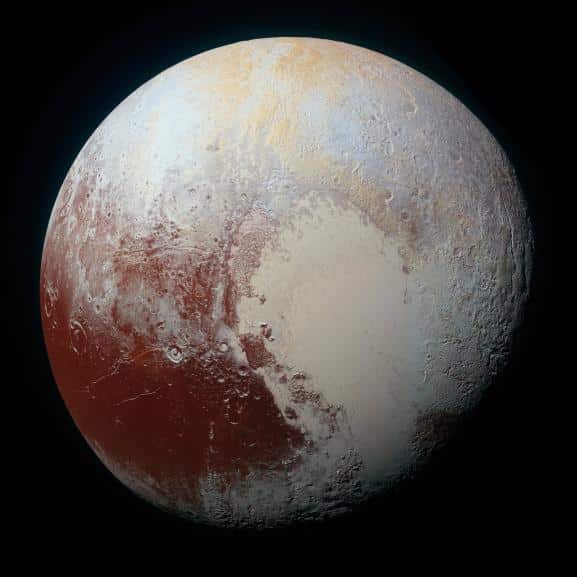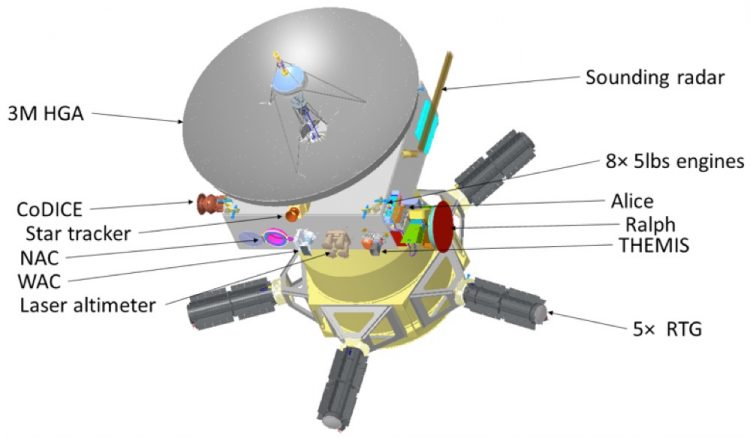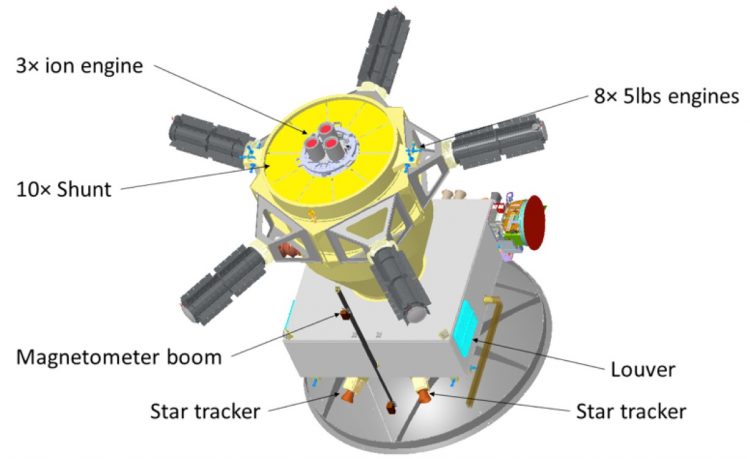Should we go back to Pluto?
25 Nov 2020|Carly Howett
- Research

In 2015 NASA’s New Horizons spacecraft flew past Pluto. The data that was returned revolutionized our understanding of this small world, showing Pluto has active geology and young surfaces. It even raised the question: Pluto could have a sub-surface ocean? If so, could Pluto’s ocean support life, and does this mean other small worlds outside our solar system could support life too? So the big question is: should we go back?
Since 2010 I have been on NASA’s New Horizons mission, as both a science Co-Investigator and the Deputy Principal-Investigator of the Ralph instrument (a colour camera and infrared spectrometer). This means I helped plan New Horizons’ flyby of everyone’s favourite ex-planet Pluto. It also meant that I got to help analyse the data the moment it was downlinked – it was truly exciting to see new images arriving – exploring this distant world remotely. So when NASA put a call out to fund future mission exploration ideas going back to Pluto was on my mind!
My mission, Persephone, was selected by NASA for further study – to determine how feasible it is to return to Pluto but this time with an orbiter and a fully-laden instrument suite. Persephone’s main science goal is to answer the question: does Pluto have an ocean? If it does the implications for astrobiology (the study of life outside the Earth) are huge because it might mean worlds like Pluto (i.e. far from a star, with no large host gas giant planet to provide additional energy) could support life too.
While this question is important, it’s far from the only one we had. For example we also wanted to know if there are currently active cryovolcanoes (i.e. volcanoes that erupt frozen ices not melted rock) that only work sometimes (i.e. were they off when New Horizons flew by)? Or are the cells on Pluto’s heart really the top of a cell which overturning slowly (a bit like a lava lamp) that erode any craters? How does Pluto’s surface and atmosphere change with time, and how do Pluto and its moons interact?
The region of space Pluto resides in is known as the Kuiper Belt. By understanding Pluto we better understand the Kuiper Belt too, but the reverse is also true: by understanding other objects in the Kuiper Belt we understand more about Pluto. Objects in the Kuiper Belt are known (unimaginatively) as Kuiper Belt Objects (or KBOs), they tend to be dark and small which makes them very difficult to observe from the Earth. Thus we also wanted to know surfaces of KBOs tell us about their origin, and by extension what do they tell us about the history of our solar system? So Persephone was also tasked with exploring a KBO en-route to Pluto and after spending time at Pluto.
The spacecraft (shown below) we designed to complete this mission caries eleven instruments, three electric propulsion (EP, or ion engines), five Radioisotope Thermoelectric Generators (RTGs) for power, and the usual navigation systems (e.g. a star tracker to know how you’re orientated, and a High Gain Antenna (HGA) to talk to the Earth). This makes it a big spacecraft!


So we have compelling science questions and a feasible spacecraft design, but what are the downsides of going to Pluto? Well our study looked at those too. The first difficulty is actually getting your spacecraft to Pluto. Every day the spacecraft is in space is a risk, something could happen you aren’t expecting and you could lose your spacecraft or one of its instruments. Also the power for a long-duration mission comes from nuclear energy, which decreases in output as time goes on. So getting to Pluto fast is important. However, breaking is hard in space and requires a lot of fuel. So it’s a balance between how fast you can go but still stop in time. We found to get to Pluto and arrive at slow enough speeds to get into orbit takes about 28 Earth-years (i.e. a year on the Earth, a Pluto-year by comparison is 248 Earth-years!). Then we wanted to do a three Earth-year tour of the Pluto system, and explore another KBO post-Pluto (which could take another eight to ten Earth-years). This adds up to being a long time, which leads to difficulty number two….
Solar power does not provide enough energy to power a spacecraft beyond Jupiter, instead power is provided by RTGs, which provide power through nuclear decay. NASA usually has the ability to purchase enough radioactive material to buy one or two RTGs every few years. However, Persephone requires five RTGs to provide the power required for the spacecraft and instruments on this long duration mission. This would not only mean NASA has to obtain more nuclear material (not an easy thing to do) it would likely mean no other mission could use any either. RTGs are also expensive, which leads us to problem number three…
Every minute a spacecraft is in space costs money, even if it’s in hibernation for a long cruise, encounters have to be planned, data downlinked, software developed, and the spacecraft health checked. The long cruise and encounter timeline combined with five RTGs, and a lot of instruments, makes this an expensive mission ($3.0B). This price tag while large is actually cheaper than some NASA missions (e.g. Europa Clipper, Mars Science Laboratory, and Galileo are all more expensive). However, it certainly has to be high on NASA’s priority list if it’s going to be funded!
So this brings us the next step, which is for the larger planetary science community to decide whether such a mission answers enough important science questions to justify its cost. The American National Research Council (NRC) on behalf of NASA will publish a decadal survey, which outlines the key scientific questions in planetary science and astrobiology and prioritizes the next medium- and large-class missions for the 2023-2032 timeframe. Whether a mission like Persephone makes the cut is up to them, but at least they know what a mission to Pluto could do and what it would cost.
Persephone showed that a return mission to Pluto has its challenges, but the possible science outcomes are extraordinary. The interior structure of Pluto (and its large moon Charon) could be determined, the surfaces of Pluto and its moons mapped at unprecedented spatial resolutions and two previously unexplored KBOs could be visited. Our results are summarized in a final report that was submitted to NASA in July 2020. Our work shows that going back to Pluto is both feasible and scientifically important. Now we just have to wait and see whether the rest of the planetary science community agree with us!
Category: Research
Author

Carly
Howett
Professor Carly Howett is an Associate Professor of Physics and Tutorial Fellow, and a Governing Body Fellow.